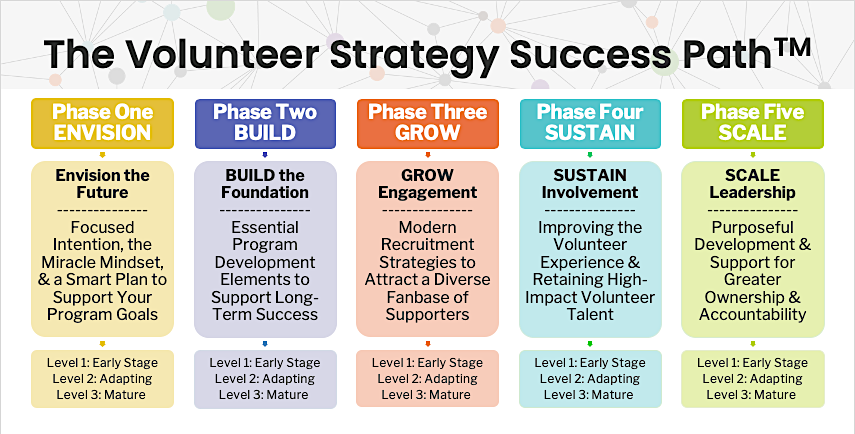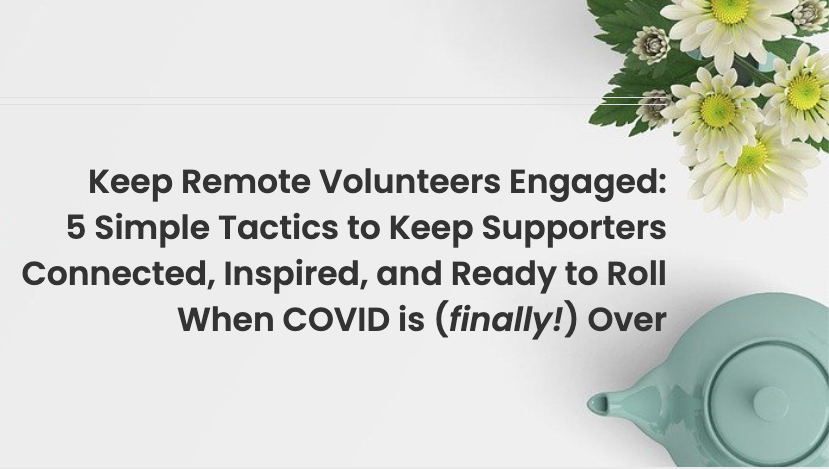
Does Your Current Volunteer Management System Actually Drive Great Results?
The presence of an effective volunteer management system can be the difference between a vibrant, high-impact nonprofit and those that struggle to find their footing.
By “volunteer management system” I mean a model for success.
While software systems can certainly be a key to successful communication and tracking of volunteer efforts, they don’t ensure success on their own.
What you really need is an effective “operating system” or operational platform for volunteer engagement.
While the consensus in the world is that volunteerism is both free and easy, anyone who has been working hard to attract and keep supporters active knows that it is anything but simple.
And, no, not everyone can do it.
It takes a special person with patience, emotional intelligence, flexibility, and incredible organizational skills to pull off true volunteer engagement success.
We know, because we work with these talented professionals daily inside our VolunteerPro membership community.
But you don’t have to be superhuman either.
In addition to innate and learned talent – combined with a passion for the nonprofit’s mission – leaders of volunteers can be equipped to become more successful, more quickly if they have a clear blueprint to work from.
But what goes into a proven success strategy? Glad you asked.
Here’s what we’ve learned from our own boots-on-the-ground experiences as nonprofit employees and over a decade of work with or members and consulting clients.
Thinking about successful volunteer engagement has evolved in recent years. In the past, a “build it and they will come” approach dominated most nonprofits. And, it worked marginally well.
Communities were willing to help, and people’s identities were deeply connected with the organizations they supported.
But in the modern digital age, the public has become more distracted, stressed, and busy. And, nonprofits are finding it harder and harder to break through a noisy marketplace.
In addition, volunteers are seeking more fulfillment in their volunteer experiences, and they expect them to match their lifestyles and needs, not the other way around.
For volunteer-driven organizations who are unwilling to evolve with the times, they are seeing a downturn in volunteer activity and struggle to meet their most basic program needs.
Instead of viewing volunteers as simply “free labor” in no need of investment, nonprofits need to develop volunteer management systems that reflect the sophistication and expectations of those they hope to engage.
Volunteers are intricately connected to the sustainability of nonprofit organizations and they can solve many pressing problems (for more on how, read this). Volunteers can help create more inclusive and equitable environments (for more on how, read this), and they can help organizations withstand the pressures of an economic recession with greater resilience as both those who raise funds and who make financial contributions themselves.
So, there is no doubt that volunteers are worth the effort, if there is an appropriate strategy in place that views volunteers as high-value talent and that takes proactive steps to manage this unique resource.
In the end, the most powerful asset an organization has is not it’s budget. It is its people.
Human capital trumps financial capital any day of the week.
While funding can come and go, it is people who have a multitude of assets to bring to bear, and who have the ability and flexibility to scale as needed.
And, what is required to bring forth the potential of people is a transformational talent management system, in this case for volunteers.
Talent management is defined as an organized, strategic process of getting the right talent, doing the right tasks, at the right time and helping that talent grow so that they can bring about the full potential of an organization’s goals and objectives.
And, simply put, an effective volunteer management system is synonymous with effective volunteer talent management.
The Secret to Volunteer Strategy Success Gleaned from a Decade of Insights
Years in the making, our bespoke members-only pathway details the key steps needed to transform a volunteer system from a fundamental level to a fully mature approach.
While no turnkey system exists that works for every organization – after all, nonprofit and public sector programs are as unique as the communities they serve and the problems they solve – there are some universal truths that guide best practice.
These are also the actions that help address some of the most critical challenges facing our sector today (for more on these, check out our state-of-the industry research findings).
In our experience, these five phases, or action steps, are the keys to mobilizing high-impact volunteer talent that will result in real results for causes and charities.
Regardless of your impact area, or how you engage volunteers, these principles and five phases are essential to a high-impact volunteer management system that gets results.
The VolunteerPro Volunteer Strategy SuccessPathTM

At VolunteerPro’s Volunteer Management Academy, the digital training arm of Tobi Johnson & Associates, our on-demand courses and member training content are aligned with these five stages.
VolunteerPro Premium Community members get access to tools, templates, training – and more! – to complete the action items inside our community resource library, all developed with the VolunteerPro Volunteer Strategy SuccessPathTM in mind.
They use a member guide to pinpoint where they need to focus their time and attention and track their progress through three levels of capacity – Early Stage, Adapting, and Mature.
We encourage them to start where they can get the most traction for their organization, and we support and celebrate their progress along the way.
How Does You Current Volunteer Management System Stack Up?
Below are our five phases to effective volunteer talent management in more detail.
Take a look and assess where your organization’s volunteer management system currently stands and where you can make improvements for better results.
How can you ensure that your agency has an engaged, enthusiastic, prepared, and committed team of supporters to help meet your most critical agency goals?
Where can you invest in building better systems of success?
Where is there untapped potential? Who on your team can help realize it? And, what support will they need to act quickly and confidently to reach success?
Phase One: ENVISION THE FUTURE (Not This, But That)
Focused Intention, the Miracle Mindset, & a Smart Plan to Support Your Program Goals
In this phase, take steps to gain clarity on your vision for volunteer engagement, its current state, and how your strategy can better align with your agency’s current and future goals and objectives. This is a critical phase because it paints a picture of the promise of what is possible when it comes to volunteer engagement at your agency. It is also an excellent time for employees who work with volunteers to reflect on their own leadership philosophies, which will set the stage for future decisions and actions
Phase TWO: BUILD THE FOUNDATION (Program Development)
Essential Program Development Elements to Support Long-Term Success
In this phase, you take steps to build the essential blueprint, or volunteer management system, that will guide the implementation of your volunteer strategy. While these elements may evolve over time, they should offer a clear picture of standard operating procedures and should guide the actions of volunteers and employees. These elements should be reviewed by and approved by agency leadership and your board of directors.
Phase THREE: GROW ENGAGEMENT (Volunteer Recruitment)
Modern Recruitment Strategies to Attract a Diverse Fanbase of Supporters
In this phase, you take steps to set goals for the number and kinds of volunteers you hope to engage and put into place a marketing and onboarding system that can help you get there. You specify the ideal volunteers you hope to mobilize and develop a strategy to build a fanbase using online and on-land tactics to reach volunteers where they are at and inspire them to take action. It is crucial in this stage that digital tools and strategies are leveled up to build awareness and visibility and communicate with volunteers where they can be found online.
Phase FOUR: SUSTAIN INVOLVEMENT (Volunteer Retention)
Improving the Volunteer Experience & Retaining High-Impact Volunteer Talent
In this phase, you set a purposeful plan to retain volunteer talent and amplify the impact of their work. This phase includes volunteer training, supervision, and recognition activities, but it also includes your strategy for inspiring deeper commitment, ownership, leadership, and accountability. Understanding volunteer perceptions is key to pinpointing motivations, so you also gather survey data and make decisions based on actionable volunteer feedback.
Phase FIVE: SCALE LEADERSHIP (Ownership & Accountability)
Purposeful Development & Support for Greater Ownership & Accountability
In this phase, you take steps to delegate and distribute responsibility for generating exceptional volunteer experiences throughout your team. As volunteer engagement grows at your agency, it will be impossible to keep tabs on everything. A trained and highly-effective team of volunteer leaders can help you scale your network and impact exponentially. You will also need to develop mutually-beneficial internal and external partnerships to help you meet your goals.
Consider these five phases. Where do your strengths lie? And, where are areas you need to improve to get greater traction, with less stress and uncertainty?
The Ultimate Goal of Your Volunteer Management System
The end goal of a well-designed and resourced volunteer management system is to create the conditions for community support to flourish and for you to meet (and even exceed) your mission and mandates.
As “architects of experience,” leaders of volunteers are the keepers of the system, but it takes support at all levels of your organization.
Volunteer support is everyone’s job.
And, everyone needs to understand the part they plan in the symphony of community engagement you create that involves contributions of time, talent, and treasure.
And the investment is well worth it.
Creating repeatable systems that can help cement your nonprofit’s sustainability and having a robust corps of volunteers can help reduce employee turnover burnout in overworked staff.
It can also help you expand your universe of support – the community safety net – that will keep your doors open and lives changed over and over again, well into the future.
More Volunteer Management Best Practices: Keep Remote Volunteers Engaged
If you’re wondering what goes into an online volunteer management strategy check out our upcoming free training. Online volunteering is a key strategy that smart nonprofits are employing to keep their volunteer teams active.
In this online seminar, we share how to keep your nonprofit top of mind for volunteers, beyond simply virtual volunteering roles. Now is the time to keep our supporters close, so that we can quickly and nimbly build momentum for post-COVID operations and service. This webinar will show you how!
Keep Remote Volunteers Engaged: 5 Simple Tactics to Keep Supporters Connected, Inspired, and Ready to Roll When COVID is (finally!) Over
February 2,3, OR 10, 2021
In this 90-Minute Free Training, You Will Learn:
- The #1 Mindset Shift that successful nonprofits must make to engage supporters in these times
- How to Instill Hope for the Future in Volunteers who may have lost the heart or connection to your mission (psst … this also helps your role remain relevant!)
- How to Re-build Stalled Momentum Due to COVID – The ONE THING that will make your nonprofit THE place volunteers can’t wait to serve
- How to Foster a Greater Sense of Community Online without the overwhelm and (fist pump!) in a way that saves you time!
- How to Build a Rock-Solid Future-Proof Volunteer Strategy that will help you hit the ground running when you resume full operations
We are offering THREE options to join us for this free webinar:
Seats sell out fast for our free webinars, so act now.










Leave A Comment